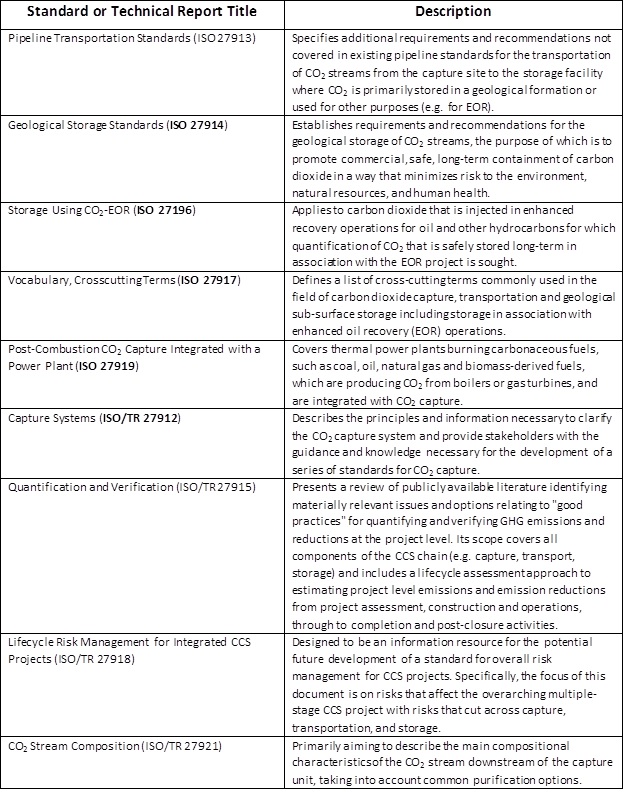PTRC’s Manager of Operations, Matt Nasehi, is one of the Canadian representatives on the International Organization for Standard’s (ISO) Technical Committee (ISO/TC-265) setting global CCS standards. He previously worked with the CSA establishing the Canadian CCS standards that were completed in 2012, and which have been used to inform the work of the international Committee. Here, he explains the importance of ISO standards. |
Climate Change and the Mitigation of CO2 Emissions
Climate change is impacting human health and safety in ways never experienced throughout human history. Over the past two hundred years, since the industrial revolution, human activities have resulted in continuous and rapid increases in production and emission of greenhouse gases (GHG). Significant increases in the atmospheric concentration of GHGs have caused the earth’s average temperature to rapidly increase to levels that are now considered unhealthy and harmful to life.
Amongst greenhouse gases, carbon dioxide (CO2) is by far the most emitted GHG and the most abundant in the atmosphere. Emitted CO2 stays in the atmosphere for a very long time (more than 300 years) and CO2 emissions make up about 75% of global emissions. Transportation, manufacturing, mining, power generation, agriculture, and many other human activities produce CO2, increasing atmospheric concentrations by 47 percent since the beginning of the Industrial Age (mid-18th Century). Figure1, by the US National Oceanic and Atmospheric Administration (NOAA), shows steadily increasing concentrations of CO2 in the atmosphere at an observatory in Hawaii over the course of 60 years. Concentrations are currently about 412 parts per million (ppm) and rising.
Figure 1: Steadily increasing concentrations of CO2 in the atmosphere observed at the NOAA’s observatory in Hawaii over the course of 60 years. (NOAA 2019)

As part of the Paris Agreement in 2015, countries agreed to limit global warming to below 2 degrees Celsius and ideally to 1.5 degrees. The latest science shows that in order to meet these goals and prevent the worst impacts of climate change, emissions will need to drop by half by 2030 and reach net-zero by mid-century. To mitigate undesirable effects of GHGs, the main sources need to be the target of effective actions in a timely manner to reduce and eliminate emissions.
Reducing emissions is a global challenge and therefore requires global solutions. Figure 2 shows the total annual CO2 emissions from different regions in the world. Small reductions in some regions with advanced economies are evident in the graph, while emissions in other regions are still continuously rising. The overall picture shows alarming global increases in CO2 and speaks clearly to the interconnected nature of this issue.
Figure 2: Annual total CO2 emissions by world region (Source Global Carbon Project)

Technologies developed for reducing GHG emissions need to be globally accepted and implemented, otherwise they will not have the desired effect. In this respect, new technologies must demonstrate their safety and effectiveness through research and development that leads to successful field applications and commercial demonstrations. This process usually takes many years for a new technology. In discussions regarding actions to mitigate climate change, there is agreement that targeting large sources of emissions, particularly those associated with essential human activities, is critically important. Since GHG emissions come from many different sectors and activities, one single solution will not eliminate all emissions. We need a portfolio of solutions capable of reducing emissions to acceptable levels. Commercialization and global implementation of effective emission reduction technologies in essential sectors such as energy and power production, steel and cement manufacturing, as well as industries related to agricultural productions is the key for timely achievement of emission reduction targets that have been set in international agreements.
Figure 3: Energy related CO2 emissions, 1990-2019 (Global CO2 emissions in 2019, IEA Newsletter, February 2020)

Figure 3 does indicate improvements in energy-related CO2 emissions in advanced economies, but in the rest of the world emissions have continuously increased. In fact, emissions outside advanced economies grew by about 400 million tonnes in 2019. These growing global energy-related emissions are indicative of growth in energy demand and a growing dependence in developing economies on fossil fuels to meet energy demands. The reality is that there are no sources of energy other than fossil fuels that can provide enough energy, fast enough, to meet the growth of developing economies. For the past 50 years, more than 80 percent of global energy has been supplied by fossil fuels. Strong demand for fossil fuels is expected to continue, and it is estimated that by mid-century hydrocarbons will still make up about 50% of the global energy mix.
It is important to point out that according to the International Energy Agency (IEA) global energy-related CO2 emissions rose by 1.7 percent in 2018 and stayed at the same level of around 33 gigatons (Gt) in 2019. From an energy perspective, this certainly is not sustainable and the need for mitigating emissions from energy and power production is very urgent. Despite all efforts and investments that have gone into development and improvements of renewable energy options like wind and solar during the past two decades, very little progress has been made in reducing global emissions.
Sustainability for the global energy system is impossible to achieve by only relying on renewables. Keeping the balance between global demand and supply for energy in a sustainable way, more than anything else, will depend on the use of technologies that are capable of large-scale emission reductions in a timely manner without sacrificing the reliability and affordability of the energy system. This emphasizes, more than ever before, the vital role of CCS as a capable technology for achieving meaningful emissions reductions in essential sectors while still allowing for hydrocarbon use, particularly in developing economies.
The Crucial Role of Carbon Capture, Utilization and Storage in Meeting Emissions Targets
Carbon Capture Utilization & Storage (CCUS) is a proven, well understood, and effective suit of technologies that have been shown to make considerable and meaningful reductions in CO2 emissions in many essential industries. CCUS captures and removes CO2 from industrial flue gases, makes it available for use in a variety of applications, and places it in deep geological formations for permanent storage.
An important advantage of carbon capture and storage (CCS) is that the technologies that make up different components of it have already been proven and have successfully demonstrated their effectiveness. In fact, CCS is the only viable technology that has been demonstrated to be capable of making meaningful reductions in CO2 emissions from set-point sources in different vital industrial sectors such as energy and power production, cement and steel manufacturing, fertilizer and chemical production and many other essential activities with high emissions. CCS includes three main components: CO2 capture from an emissions source, transportation of the captured CO2 from the source to the storage site, and then permanent storage in deep geological formations.
Continuous advancements in technologies have been successful in making CO2 capture possible from many large industrial sources of emissions. Pipelines and other means of transportation for fluids are well established, making the transportation of CO2 from source facilities to utilization and storage locations very efficient. Also, the knowledge and expertise gained from many decades of mining and geological exploration have provided us with the necessary knowledge of geological requirements for CO2 storage in deep subsurface formations.
The use of CO2 in the oil and gas industries for the past 50 years, mainly for injection into reservoirs to enhance production of oil and gas from these formations, is one well-known practice. Knowledge and learnings from these practices resulted in a number of geological storage projects that started emerging in the 1990s that have stored large quantities of anthropogenic CO2 in different parts of the world. These projects have successfully demonstrated the capabilities and effectiveness of CCS technologies in reducing emissions.
The International Organization of Standards and ISO TC-265: Setting International CCS Standards
CCS is considered by many countries and international organizations such as the International Energy Agency (IEA) to be an important part of a portfolio of mitigation actions for energy-related emissions reductions required by midcentury. With obvious funding issues in today’s economic times, developing CCS standards that provide guidelines for correct and safe implementation of the technology is very important. Internationally recognized standards provide the assurance needed for more global acceptance of technologies.
To make the implementation of CCS more effective and to ensure its applications globally are practiced in a correct and safe manner, the International Organization for Standardization (ISO) has been developing the international standards for CCS since 2012. Developed by global experts, ISO standards are widely accepted around the world for ensuring that technologies, products, and services are safe, reliable and of good quality. The ISO is an independent, non-governmental international organization with a membership of 164 national standards bodies (e.g. each country has its own national standards bodies) represented in 333 Technical Committees. Through its members, the ISO brings together experts to share knowledge and develop voluntary, consensus-based, market-relevant international standards that support innovation and provide solutions to global challenges. ISO provides high-level management of the international standards development process of its 333 Technical Committees.
The work on CCS standards first started in 2009 in Saskatchewan. Over the next three years, a group of Canadian and US experts assembled by the Canadian Standards Association (CSA) develop the world’s first set of standards for the geological storage of CO2. Saskatchewan was already host to the world’s first full-scale CCUS project that had started a decade earlier – the Weyburn-Midale project – which utilized and stored capturedCO2 from a coal gasification facility in North Dakota. The CO2 was transported via pipeline to the two oil fields in southern Saskatchewan and injected into the reservoirs to improve production efficiencies and store the CO2 in the oil reservoirs. Ongoing operations of Weyburn and Midale, including using additional CO2 sources from SaskPower’s Boundary Dam Carbon Capture Facility, have stored over 40 million tonnes of CO2 in the oil fields.
To investigate the safety and permanence of CO2 storage in oil reservoirs, the PTRC undertook the management of a measurement, monitoring and verification program (known internationally as the IEAGHG Weyburn-Midale CO2 Monitoring and Storage Project). PTRC gathered experts from different fields of science and industry to work on this project between 2000 and 2015. The result was a successful international collaboration that developed technical guidelines for the monitoring and measurement requirements for CO2 storage in oil reservoirs. One of the most important achievements of this project was to demonstrate that CO2 could be safely and effectively stored in oil fields. It also generated an invaluable wealth of knowledge that was shared globally. This knowledge and expertise became the cornerstone for the development of Canadian CCS standards, which were a precursor to the ISO CCS standards development. Many of the experts involved in the Weyburn-Midale project also participated in the CCS standards technical committee, and applied their knowledge and experience toward the development of the Canadian standards.
The publication of CSA standards (Z-741) for geological storage of carbon dioxide was announced in Regina in 2012. As a direct result of that work, the ISO accepted a proposal by the Standards Council of Canada (SCC) to create an international committee to advance the development of international CCUS standards under the ISO. The ISO Technical Committee 265 (TC-265) was formed and started its work on the CCS standards in 2012. The Canadian standards (CSA Z-741) covered the geological storage of CO2 in deep saline formations. The ISO standards cover all components of CCS including CO2 capture, transportation, and geological storage both in deep saline formations and also in oil fields. The ISO committee consists of different working groups of experts from different countries in each of those areas. Membership of the committee is drawn from experts with full project life cycle knowledge and experience. Canada chairs the international committee, and the CSA – as the secretariat of the committee – manages the activities.
Figure 4: Member Countries and International Organizations in ISO Technical Committee (TC 265) for developing CCS standards.

The most important aspect of ISO standards is its international usefulness and acceptability. Usually, each country develops their own standards for different purposes that pertain to situations and conditions specific to that country. Those situations and conditions may or may not exist in other countries. However, it is important to note that ISO standards are developed to be globally useful, through the close collaborative work of experts form different countries. Reaching consensus through extensive discussions of details, ISO standards take into account the variations and differences that exist in different settings and different countries to ensure the global applicability and usefulness of the standards. That is why ISO standards have the international reputation for being useful and effective.
Since 2016, five standards and four technical reports have been published by the ISO technical committee (TC 265) for different areas of CCS technologies. See Table 1. Also, reports are available from the ISO site at https://www.iso.org/standards.html,
Table 1. Completed standards and technical reports from the ISO Technical Committee 265
Moving Forward: A Future for CCS Globally
ISO standards for CCS are not necessarily prescriptive, particularly in rapidly evolving technology domains (such as CO2 Capture) to avoid hampering innovation. There are also certain details that are site specific and cannot be addressed in the scope of international standards. Those details are for the users to determine, but enough information is provided in the standards to ensure they guide the users to implement the technology in a safe and effective way. Some countries have already adopted some of these standards and are using them in policy and regulatory developments. The use of these standards for the 45Q related emission reduction verifications in the US is a good example of such approaches.
CCS standards provide support to GHG emissions reduction technology consistent with industry best practices and ensure that CCUS projects are safe for future generations. Compliance with the ISO standards provide the assurance that is required for the public acceptance of technologies. This is also important in terms of providing the confidence that helps governments, industry, and investors in their decision-making regarding CCUS technologies. The standards are also an effective way to inform public confidence in CCUS as properly regulated and safe.
The time available to limit temperature rises to 1.5°C is running out. Most credible models and scenarios developed by internationally accepted and recognized organizations such as the IEA, the World Resources Institute (WRI) and others agree that CCS is needed, and widescale implementation of CCS technology is critical to meeting the international climate change mitigation goals. CCS and its widespread application in different sectors are now more necessary than ever for achieving global emission reduction targets.



